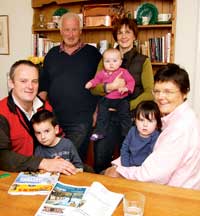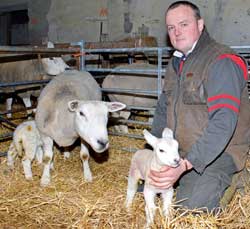Management Matters: Focus on stock sees cereals cut back at Fearn

This year is on course to see a significant “up horn, down corn” swing away from cereals and lead to an increase in livestock numbers at Fearn Farm at Tain in Ross-shire, run by John Scott and his wife, Fiona, and parents, James and Janet.
Looking back on the high and low points of 2009, John Scott says the business had made good progress in a number of areas but one large cloud is the lack of profit in the arable sector.
The Scotts plan to cut back their barley acreage by up to 180 acres in 2010 and, with reasonable contracts for malting barley pretty much non-existent, John doesn’t hold back when describing the cereals situation at the moment.
“The cereals side of the business is frankly, hellish. It’s not good at all even with a reasonable harvest and decent yields,” he says.
“The fact is we need £130-£140/tonne to break even and last year we struggled to get £100/tonne which makes no sense at all.
“Things are looking pretty bleak in terms of trying to secure contracts for next season and there is a lot of negative speculation emerging as a result of the reluctance of the grain buyers to commit to contracts.
“We have to be realistic – there has been, and will be for the next year or two, too much malting barley being grown so we have to look at other options for the ground and grass and a slight increase in stock would seem the obvious route to take.
“We are, however, fortunate in our situation in that we have a stock option and any arable land that hasn’t performed to its optimum will be sown into grass. This will do the ground good and, when cereal prices improve, we can bring these fields back into the arable rotation.”
So far the Scotts have sold a third of their wheat crop forward at £122.50/t for November delivery and they would like to put pen to paper for a few more tonnes by the time spring sowing time arrives.
Given the current lack of profitability in the cereals side of the business their decision to invest in a new drier – match-funded by a Scottish Rural Development Programme grant – is one which John is starting to question.
“At the time we applied for the grant we were getting £180/t for barley but we are now in a very different environment. There’s no doubt having a drier will be beneficial to us in the long-term and give us more control about when we market our grain but in the short-term it is certainly hard to justify.”
The Scotts plan to grow the livestock side of the business and build on some of the key successes of 2009. Among these is a marked step-up in the fertility of the commercial herd – of the 109 commecial cows scanned this November 96% were in-calf – although John thinks there is still scope for further improvement.
One area of concern was the number of calves lost at calving this spring.
“It was a strange calving – we had a variety of disasters for various different reasons but mainly due to poor presentation. In hindsight we were maybe too good to the cows nutritionally pre-calving, we are keeping a closer eye on condition this year,” says John.
The consistent quality of the calves being produced is something which gives him a real sense of pride and the Scotts are pleased with the composition of the herd. “We are looking to increase numbers and will keep more heifers this year – we retained 25 heifers last year and will retain a similar number this year,” he said.
“We have a very good crop of calves this year. Weaning weights and weight gain post weaning have been good with bulls on an add-lib barley based diet while the heifers are on a daily barley based ration plus silage.”
The Scotts also have a great crop of young pedigree Shorthorn bulls, including three bred with Australian Shorthorn genetics, two of which are being retained as stock bulls while the other, which tipped the scales at over a tonne at 20 months old, is destined for the spring bull sales at Stirling, accompanied by a younger homebred bull.
“We’re very pleased with the Australian genetics we have introduced. Both crops of calves which we have on the ground are delivering exactly what we are after. The bull sales in February will see us selling our first Shorthorn bull bred using Australian genetics and we’re looking forward to seeing how he sells. We’ll be calving 30 Shorthorns this year, mainly to the two young bulls we have kept and our aim is to push numbers up further, culling ruthlessly as we go. Our pedigree herd is very much a long-term investment and we are carefully laying down the foundations of what we hope will be a very strong herd.”
The Scotts’ decision to continue outwintering their cows on forage crops and straw is one they are convinced is the right move. Cows are outwintering well, leaving good shed space to overwinter the youngstock and lamb ewes inside. One big benefit of outwintering the cows is it keeps them fit although the plunging temperature over the past few weeks – falling as low as minus 15 degrees overnight – is a source of some concern for the Scotts.
“We had six inches of snow pre-Christmas and since then it has been very frosty – around -10 degrees some on occasion and lower over night. It doesn’t seem to have affected the cows too much, although anything that is slightly leaner than the rest has been taken inside as a precaution.” says John.
 The sheep side of the business performed well in 2009, with the lambs averaging £70/head overall. One key objective for the Scotts has been to get as many lambs as possible finished off grass in summer, with just a little supplementary creep feed.
The sheep side of the business performed well in 2009, with the lambs averaging £70/head overall. One key objective for the Scotts has been to get as many lambs as possible finished off grass in summer, with just a little supplementary creep feed.
“Our February-born lambs started to go off in May with the majority were off by September with only a handful left to go away by December,” says John.
One success story of the past year has been a marked reduction in the pneumonia problem which had dogged the Scotts’ lambs. The Scotts attribute this improvement to their strategy of giving new-born lambs 0.5ml of long acting antibiotic and a strict policy of getting later lambing ewes and lambs out of the lambing shed and onto grass as soon as possible.
The Scotts have 320 pedigree and commercial ewes synchronised to lamb this spring between the 8th and 15th of February and a further 520 and 120 hoggs set to lamb in mid-March. “This will allow us to make the best use of our available labour while giving us lambs to sell weekly from the first week in May. There should be a months’ lull between the two busy lambing blocks which will give us a chance to catch our breath and get caught up,” said John.
The ewes are being out wintered and have been performing very well. However, with the recent cold snap, John is starting to have concerns about the ewes maintaining condition and, as of this week, they have started giving the early lambing ewes hard feed (a mix of barley, beet pulp and protein). The ewes have so far scanned well with good lamb numbers expected.
Fearn Update:
30 tups (Beltex/Texel/Lleyn) sold to average £550 via Carlisle and Dingwall markets and private sales.
Straw prices are proving strong. The Scotts have been selling barley straw to farmers in the north and west of Scotland for £10/bale for 4 foot x 4 foot bales and £20/bale for quadrant bales. They predict the price will continue to strengthen with a lack of supply of good, stored straw.
14 commercial and pedigree heifers were sold via Dingwall Mart’s website and privately to average £1380. This method of selling proved simple and effective and the Scotts would definitely repeat the experience.
Empty cows after scanning sold to average £950 a head.
For more information on Fearn Farm click here
For more information on other Management Matters farms click here

